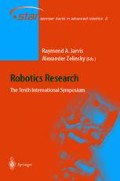Abstract
Teleoperation can be improved if humans and robots work as partners, exchanging information and assisting one another to achieve common goals. In this paper, we discuss the importance of collaboration and dialogue in human-robot systems. We then present collaborative control, a system model in which human and robot collaborate, and describe its use in vehicle teleoperation.
Access this chapter
Tax calculation will be finalised at checkout
Purchases are for personal use only
Preview
Unable to display preview. Download preview PDF.
References
Abella A, Gorin A (1999) Construct algebra: analytical dialog management. In Proc Annual Meeting of the ACL.
Albus J et al. (1987) NASA/NBS standard reference model for telerobot control system architecture (NASREM). Technical note, NIST.
Baltus G et al. (2000) Towards personal service robots for the elderly. In Proc WIRED. Carnegie Mellon University, Pittsburgh.
Bonasso P (1999) Issues in providing adjustable autonomy in the 3T architecture. In Proc Spring Symposium on Agents with Adjustable Autonomy, AIAA, Menlo Park.
Churcher G et al. (1997) Dialogue management systems:a survey and overview. Report 97.6, School of Computer Studies, University of Leeds.
Clarke R (1994) Asimov’s laws of robotics: implications for information technology. IEEE Computer, 26(12), 27(1).
Fong T (2001) Collaborative control: a robot-centric model for vehicle teleoperation. PhD thesis, Carnegie Mellon University, Pittsburgh. CMU-RI-TR-01-34.
Fong T et al. (2001a) A personal user interface for collaborative human-robot exploration. In Proc iSAIRAS, Canadian Space Agency, Ottawa.
Fong T et al. (2001b) A safeguarded teleoperation controller. In Proc Intl Conf on Advanced Robotics, IEEE, Piscataway.
Goren-Bar D (2001) Designing model-based intelligent dialogue systems. In Information Modeling in the New Millennium. Idea Group, London.
Laengle T et al. (1997) Cooperation in human-robot-teams. In Proc Intl Conf on Informatics and Control, Russian Academy of Science, Moscow.
Lansdale M, Ormerod T(1994) Understanding interfaces: a handbook of human-computer dialogue. Academic Press, London.
Milgram P et al. (1993) Applications of augmented reality for human-robot communication. In Proc Intl Conf on Intelligent Robots and Systems, IEEE, Piscataway.
Myers K, Morley D (2001) Human directability of agents. In Proc. Intl Conf on Knowledge Capture, ACM, New York.
Nourbakhsh I et al. (1999) An affective mobile robot educator with a full-time job. Artificial Intelligence, 114(1–2).
Rosenblatt J (1997) DAMN: A distributed architecture for mobile navigation. PhD thesis, Carnegie Mellon University, Pittsburgh. CMU-RI-TR-97-01.
Sheridan T (1997) Eight ultimate challenges of human-robot communication. In Proc ROMAN, IEEE, Piscataway.
Terveen L (1994) An overview of human-computer collaboration. Knowledge-Based Systems, 8(2–3).
Author information
Authors and Affiliations
Editor information
Editors and Affiliations
Rights and permissions
Copyright information
© 2003 Springer-Verlag Berlin Heidelberg
About this paper
Cite this paper
Fong, T., Thorpe, C., Baur, C. (2003). Collaboration, Dialogue, Human-Robot Interaction. In: Jarvis, R.A., Zelinsky, A. (eds) Robotics Research. Springer Tracts in Advanced Robotics, vol 6. Springer, Berlin, Heidelberg. https://doi.org/10.1007/3-540-36460-9_17
Download citation
DOI: https://doi.org/10.1007/3-540-36460-9_17
Published:
Publisher Name: Springer, Berlin, Heidelberg
Print ISBN: 978-3-540-00550-6
Online ISBN: 978-3-540-36460-3
eBook Packages: Springer Book Archive

